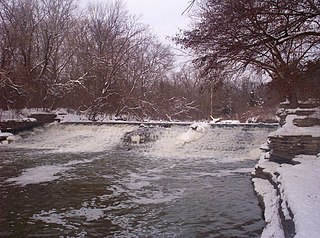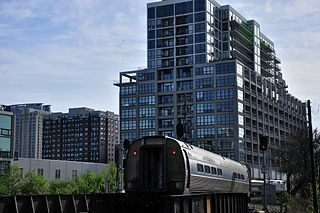
Dearborn is a city in the State of Michigan. It is located in Wayne County and is part of the Detroit metropolitan area. Dearborn is the eighth largest city in the State of Michigan. As of the 2010 census, it had a population of 98,153 and is home to the largest Muslim population in the United States. First settled in the late 18th century by French farmers in a series of ribbon farms along the Rouge River and the Sauk Trail, the community grew with the establishment of the Detroit Arsenal on the Chicago Road linking Detroit and Chicago. It later developed as a major manufacturing hub for the automotive industry, as Henry Ford built his Rouge River Ford Complex here.

The Grand Trunk Railway was a railway system that operated in the Canadian provinces of Quebec and Ontario and in the American states of Connecticut, Maine, Michigan, Massachusetts, New Hampshire, and Vermont. The railway was operated from headquarters in Montreal, Quebec, with corporate headquarters in London, England. It cost an estimated $160 million to build. The Grand Trunk, its subsidiaries, and the Canadian Government Railways were precursors of today's Canadian National Railways.

Amasa is an unincorporated community and census-designated place (CDP) in southern Hematite Township, Iron County, Michigan, in the United States. As of the 2010 census it had a population of 283.

Bark River is an unincorporated community located in Delta County in the U.S. state of Michigan. It is located in Bark River Township near the Bark River, from which it is named. It is situated on U.S. Highway 2 and U.S. Highway 41 about 13 miles west of Escanaba and just east of the Hannahville Indian Reservation.
Bark River is a 23.7-mile-long (38.1 km) river on the Upper Peninsula of the U.S. state of Michigan. The river flows into Green Bay on Lake Michigan in Ford River Township about 15 miles (24 km) southwest of Escanaba at 45°34′22″N87°14′34″W.

Watersmeet is an unincorporated community and census-designated place (CDP) in Watersmeet Township, Gogebic County, Michigan, in the United States. As of the 2010 census, the CDP had a population of 428, out of a total population in the township of 1,417. The community was platted in 1884, designated as a station of the Chicago, St. Paul, Minneapolis & Omaha Railways.

The Grand Trunk Western Railroad Company is an American subsidiary of the Canadian National Railway operating in Michigan, Illinois, Indiana and Ohio. Since a corporate restructuring in 1971 the railroad has been under CN's subsidiary holding company the Grand Trunk Corporation. Grand Trunk Western's routes are part of CN's Michigan Division. Its primary mainline between Chicago, Illinois, and Port Huron, Michigan, serves as a connection between railroad interchanges in Chicago and rail lines in eastern Canada and the Northeastern United States. The railroad's extensive trackage in Detroit and across southern Michigan has made it an essential link for the automotive industry as a hauler of parts and automobiles from manufacturing plants.

The city of Chicago is located in northern Illinois, United States, at the south western tip of Lake Michigan. It sits on the Saint Lawrence Seaway continental divide at the site of the Chicago Portage, an ancient trade route connecting the Mississippi River and the Great Lakes watersheds.

The St. Clair Tunnel is the name for two separate rail tunnels which were built under the St. Clair River between Sarnia, Ontario and Port Huron, Michigan. It was the first full-size subaqueous tunnel built in North America. It is a National Historic Landmark of the United States, and has been designated a civil engineering landmark by both US and Canadian engineering bodies.

The River Rouge is a 127-mile river in the Metro Detroit area of southeastern Michigan. It flows into the Detroit River at Zug Island, which is the boundary between the cities of River Rouge and Detroit.

The Michigan Central Railroad was originally incorporated in 1846 to establish rail service between Detroit, Michigan and St. Joseph, Michigan. The railroad later operated in the states of Michigan, Indiana, and Illinois in the United States, and the province of Ontario in Canada. After about 1867 the railroad was controlled by the New York Central Railroad, which later became part of Penn Central and then Conrail. After the 1998 Conrail breakup Norfolk Southern Railway now owns much of the former Michigan Central trackage.

The St. Charles Air Line is a rail line in Chicago, Illinois, partially owned by the BNSF Railway, Union Pacific Railroad, and Canadian National Railway.
The Days River is a 30.1-mile-long (48.4 km) river on the Upper Peninsula of the U.S. state of Michigan.

Ford River is an unincorporated community in Delta County, in the U.S. state of Michigan.
The Iron River is a 17.1-mile-long (27.5 km) river in Iron County, Michigan, in the United States. It flows from northwest to southeast through the city of Iron River to the Brule River. It is part of the Menominee River watershed, flowing to Lake Michigan.
The CSX Saginaw Subdivision is a railroad line in the U.S. state of Michigan. The line runs 105 miles from Toledo, Ohio to Saginaw, Michigan; although since 2006, the section from Mt. Morris to Saginaw has been leased to the Lake State Railway, but is still occasionally used by CSX.

Battle Creek station, listed in the National Register of Historic Places as the Penn Central Railway Station, is a disused train station in Battle Creek, Michigan. It opened on July 27, 1888. Rogers and MacFarlane of Detroit designed the depot, one of several Richardsonian Romanesque-style stations between Detroit and Chicago in the late nineteenth century. Thomas Edison as well as Presidents William Howard Taft and Gerald Ford visited here. The depot was acquired by the New York Central Railroad in 1918, Penn Central in 1968 and Amtrak in 1970. The depot was listed on the National Register of Historic Places in 1971.

Wilson is an unincorporated community in Menominee County, Michigan, United States. Wilson is located in Harris Township along U.S. Highway 2 (US 2), US 41 and the Canadian National Railway, 4.5 miles (7.2 km) east-northeast of Powers. Wilson has a post office with ZIP code 49896.

The Wabash Railroad was a Class I railroad that operated in the mid-central United States. It served a large area, including track in the states of Ohio, Indiana, Illinois, Iowa, Michigan, and Missouri and the province of Ontario. Its primary connections included Chicago, Illinois; Kansas City, Missouri; Detroit, Michigan; Buffalo, New York; St. Louis, Missouri; and Toledo, Ohio.

Narenta is an unincorporated community in Delta County, in the U.S. state of Michigan.















